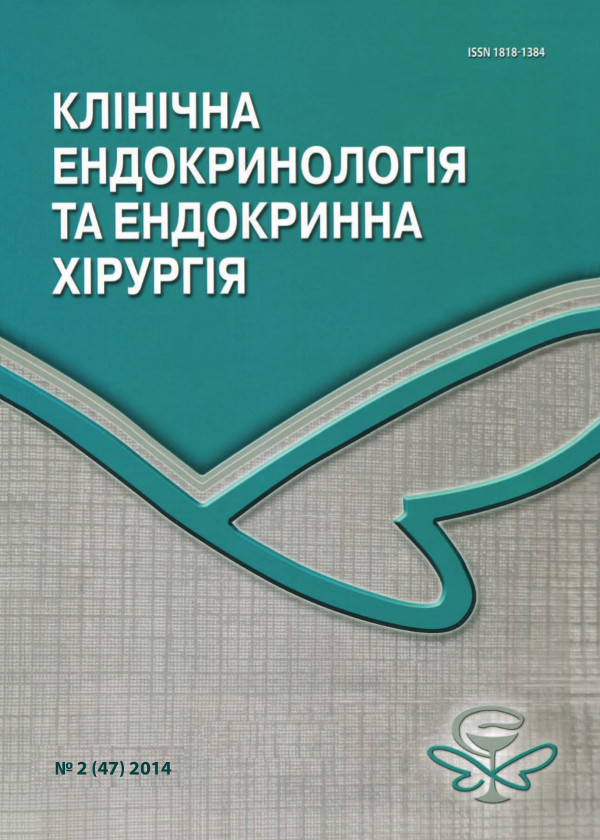Поширеність синдрому Шерешевського-Тернера у дітей в Україні та його генетичні варіанти
DOI:
https://doi.org/10.24026/1818-1384.2(47).2014.75489Ключові слова:
Turner’s syndrome, growth retardation, karyotype, physical development, prevalenceАнотація
Turner’s syndrome is one of the most common genetic disorders associated with abnormalities of the X chromosome. The purpose of our study was to investigate the prevalence Turner’s syndrome, frequency of variants of the karyotype, age of diagnosis, degree of growth retardation in girls with Turner’s syndrome in Ukrainian population. A retrospective analysis of registration cards 387 girls in aged 0.11-18.2 years from the registry of patients with Turner’s syndrome for the period from 2004 to 2009. Prevalence of the Turner’s syndrome in Ukraine was 77.5 per 100 000 live births. The average age at diagnosis Turner’s syndrome in Ukrainian population was 9.8±4.7 years (0.10-17 years). At 1.6% of girls were diagnosed in the first year, 3.5% at an early age (1-4), the 9.3% of a pubertal age (4-8 years), 18.8% early puberty (8-12 years), from 66.8% in adolescence (12-18 years). There is a growing diagnosis Turner’s syndrome age with a peak during puberty. Average growth of girls was 127.4±17.8 cm (53-160.5 cm), the average delay of growth – 3.2±1.08 SDS (-6.8 – -0.2 SD), which is below the 5th percentile for the population of healthy girls. The average weight of girls was 31.9±11.4 kg (4.6-68.5 kg), BMI percentile 49.3±27.9. Bone age average was 10.4±3.2 years (0-19 years) with a delay relative to chronological age 2.8±1.8 years (0.5-8.5 years). The incidence of chromosomal abnormalities in the choices girls Turner’s syndrome in Ukraine was as follows (n=381): monosomy (45, X) – 60.6%; mosaics (45,Х/46,XX) – 23.6%; mosaics with polysomes X – 1.3%; structural abnormalities – 14.4%.
Посилання
Gravholt C.H. Epidemiological, endocrine and metabolic features in Turner syndrome // Eur. J. Endocrinol. – 2006. – Vol. 151 (6). – P. 657-687. https://doi.org/10.1530/eje.0.1510657
Hoxha P., Grimchi L. et al. The characteristics of Turner’s syndrome in Albania // 7th ESPE/LWPES Joint Meetings Paediatric Endocrinology, Lyon. – 2005. – P. 241.
Wikiera B., Barg E., Konieczna A. et al. Factors influencing the frequency and the time of Turner’s syndrome diagnosis // 7th ESPE/LWPES Joint Meetings Paediatric Endocrinology, Lyon. – 2005. – P. 1-240.
Schweizer R., Blumenstock G., Mangelsdorf K. et al. Prevalence and incidence of endocrine disorders in children: results of a survey in Baden-Wuerttemberg and Bavaria 2000-2001 // Klin. Paediatr. – 2010. – Vol. 222 (2). – P. 67-72. https://doi.org/10.1055/s-0029-1241868
Savendahl L., Davenport M.L. Delayed diagnoses of Turner’s syndrome: proposed guidelines for change // J. Pediatr. – 2000. – Vol. 137 (4). – P. 455-459. https://doi.org/10.1067/mpd.2000.107390
Наказ МОЗ No 55 від 03.02.2009. Протокол надання медичної допомоги дітям за спеціальністю «Дитяча ендокринологія» / www.moz.gov.ua.
Lyon A. J., Preece M. A., Grant D. B. Growth curve for girls with Turner syndrome // Arch. Dis. Childhood. – 1985. – Vol. 60. – P. 932-935. https://doi.org/10.1136/adc.60.10.932
Greulich W.W. Radiographic atlas of skeletal development of the hand and wrist / Greulich W.W, Pyle S.I. – Stanford: Stanford University Press, 1959. – 214 с.
Hook E.B., Warburton D. Turner syndrome revisited: review of new data supports the hypothesis that all viable 45,X cases are cryptic mosaics with a rescue cell line, implying an origin by mitotic loss // Hum. Genet. – 2014. – Epub. ahead of print. – Режим доступу: http://www.ncbi.nlm.nih.gov/pubmed/24477775. https://doi.org/10.1007/s00439-014-1420-x
##submission.downloads##
Як цитувати
Номер
Розділ
Ліцензія

Ця робота ліцензується відповідно до Creative Commons Attribution-NonCommercial 4.0 International License.





